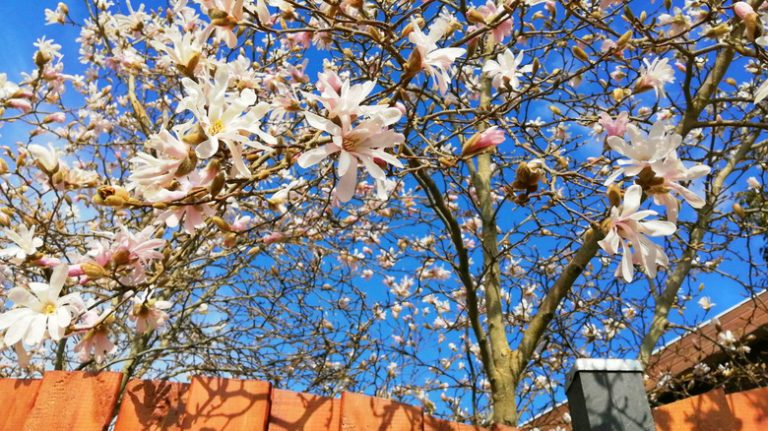If you are looking to buy ginkgo trees, you have come to the right place! At Carlton’s Nursery, we offer a wide variety of ginkgo trees for sale. With a quick Google search, you will find that ginkgos are one of the most popular and beloved trees on the market.
Ginkgo trees can grow to be very tall, with some cultivars reaching heights of over 100 feet. However, there are also more compacted varieties available for smaller spaces. No matter the size, ginkgos are known for their beautiful fan-shaped foliage, which turns a stunning yellow in the fall.
When it comes to planting and care, ginkgos are relatively easy to grow and are generally low-maintenance. They thrive in full sunlight and can tolerate a wide range of soil types, although they prefer well-drained soil. Ginkgos are also drought-tolerant once established, but they still need regular watering, especially during the first few years after being planted.
Before making a purchase, it’s important to know that ginkgos are dioecious, meaning that they have separate male and female trees. Female trees produce fruit that can be messy and have an unpleasant odor when it falls. If you prefer a fruitless tree, be sure to choose a male cultivar.
In terms of pests and diseases, ginkgo trees are relatively resistant. However, some common pests that can affect ginkgos include ginkgo moth and scale insects. Regular pruning can help to keep these pests at bay.
If you are still unsure about buying a ginkgo tree, our knowledgeable staff is here to help. We have a wide range of ginkgo tree varieties available, and we can provide you with all the information and instructions you need to plant and care for your tree. Feel free to browse our FAQs or contact us directly for more information. We guarantee that you will be pleased with your purchase of a ginkgo tree from Carlton’s Nursery!
Sky Tower Ginkgo Tree
The Sky Tower Ginkgo Tree is a tall and fast-growing tree that can reach heights of over 70 feet. Known for its healthy and full foliage, this tree is a popular choice for customers looking to add a unique and beautiful tree to their landscape.
The Sky Tower Ginkgo Tree is a fruitless variety, which means it will not produce any messy or stinky fruit. This makes it an ideal choice for customers who want a low-maintenance tree without the hassle of cleaning up fallen fruits.
When it comes to growing the Sky Tower Ginkgo Tree, it is important to find a planting location that provides full sunlight. The tree can grow in a variety of soil types, but it thrives best in well-drained soil that is rich in nutrients. Before planting, it is recommended to dig a hole that is twice as wide and just as deep as the tree’s root ball.
Once planted, the Sky Tower Ginkgo Tree requires regular watering, especially during the first few years of growth. However, it is important not to overwater the tree, as this can lead to root rot and other diseases. In addition to watering, the tree benefits from regular fertilizing in early spring and late fall.
The Sky Tower Ginkgo Tree is known for its resistance to pests and diseases. However, it may attract voles, a type of small animal that can damage the trunk and roots of the tree. To prevent this, customers can protect the tree by forming a wire mesh barrier around the base.
When it comes to shaping and pruning the tree, it is best to follow the instructions provided in the care guide. This will ensure that the tree maintains its desired form and grows to its full potential. If pruning is necessary, it is recommended to do so during the winter when the tree is dormant.
In summary, the Sky Tower Ginkgo Tree is a beautiful and low-maintenance tree that is perfect for customers looking to add a unique element to their landscape. With its tall and fastigiated growth habit, this tree stands out among others. Whether used as a focal point or planted in rows, the Sky Tower Ginkgo Tree is a stunning addition to any garden.
For more information about the Sky Tower Ginkgo Tree and related FAQs, customers can visit our website or order directly from our online store. We offer a variety of sizes to accommodate different landscaping needs. Don’t wait too long to purchase one of these amazing trees, as they are highly popular and can sell out fast!
Ginkgo Trees for Sale – Buying Growing Guide
Are you interested in buying and growing Ginkgo trees? Look no further! This guide will provide you with all the information you need to make an informed purchase and ensure the healthy growth of your Ginkgo tree.
Buying a Ginkgo Tree
There are many places where you can buy Ginkgo trees, both online and in nurseries. Before making a purchase, make sure to research the various cultivars available and choose the one that best suits your needs. Additionally, check the plant’s description for its size at maturity and whether it is fruit-bearing or fruitless.
Growing Guide
Once you have purchased your Ginkgo tree, it’s important to provide the right care to help it thrive.
Sunlight: Ginkgos prefer full sun, so make sure to plant them in an area that receives at least six hours of direct sunlight per day.
Watering Needs: Ginkgos are relatively drought-tolerant but should be watered regularly, especially during dry spells. Water deeply to ensure the roots receive enough moisture without becoming waterlogged.
Soil Requirements: Ginkgos can grow in a wide range of soil conditions, but they prefer well-draining soil. Make sure the area where you plant your Ginkgo tree has good drainage to avoid waterlogging and root rot.
Fertilizing: Ginkgos are not heavy feeders, but you can fertilize them in the early spring using a slow-release fertilizer. Follow the instructions on the package for the appropriate application rate.
Pruning: Ginkgos generally require minimal pruning. However, you can remove any dead or diseased branches to maintain the tree’s health and appearance.
Pests and Diseases: Ginkgos are relatively pest and disease-resistant. However, they can be susceptible to aphids, spider mites, and caterpillars. Regularly inspect your tree for any signs of infestation and treat accordingly.
Frequently Asked Questions (FAQs)
We understand that as a customer, you may have some related questions or concerns. Here are some frequently asked questions about Ginkgo trees:
Q: Do Ginkgo trees produce fruit?
A: Yes, most Ginkgo trees are fruit-bearing, but there are also fruitless cultivars available.
Q: Are Ginkgo trees suitable for all climate zones?
A: Ginkgo trees can adapt to a wide range of climate zones, but they prefer moderate temperatures and do best in hardiness zones 3-9.
Q: How tall do Ginkgo trees grow?
A: Ginkgo trees can grow up to 80 feet tall, but some cultivars are more compact and stay shorter.
Q: Do Ginkgo trees have any special needs?
A: Ginkgo trees have relatively low maintenance needs. However, they prefer well-draining soil, regular watering, and full sun exposure.
Q: Where can I buy Ginkgo trees?
A: Ginkgo trees are available for sale both online and in nurseries. You can also try searching on Google for local suppliers in your area.
In Conclusion
By following this guide and providing the appropriate care, you can enjoy a healthy and beautiful Ginkgo tree. Remember to review the specific care instructions that come with your tree to ensure its optimal growth. Happy growing!
Plant Care
When it comes to the care of Ginkgo trees, there are many factors to consider. Ginkgo trees are known for their fast growth and can quickly reach a large size. They are also known for their unique leaves, which turn a beautiful yellow color in the fall.
To ensure the healthy growth of your Ginkgo tree, it is important to plant it in an area with well-drained soil. Ginkgos can tolerate a wide range of soil conditions, but they prefer soil that is rich in nutrients. They also need full sunlight to thrive, so be sure to choose a planting location that receives direct sunlight throughout the day.
Ginkgo trees are generally low maintenance and do not require frequent watering. They have a deep root system that can reach nutrients and water from deep within the soil. However, it is important to water the tree thoroughly during dry periods, especially when it is first planted. After the tree is established, it should only be watered during extended periods of drought.
It is recommended to fertilize Ginkgo trees once a year to provide them with the necessary nutrients. Use a slow-release fertilizer with a balanced formula. Apply the fertilizer in early spring, following the instructions on the packaging.
Ginkgo trees are relatively pest and disease resistant. They are not commonly attacked by insects or diseases. However, they can be affected by voles, which are small animals that chew on the tree trunk. To protect your Ginkgo tree from voles, you can create a wire mesh barrier around the trunk or use vole repellents.
When it comes to shaping Ginkgo trees, it is best to let them grow naturally. However, if you want a more compact form, you can prune the branches in late winter or early spring. Be sure to follow proper pruning techniques to avoid damaging the tree.
Ginkgo trees are an excellent choice for landscaping due to their unique appearance and low maintenance needs. They can be planted in a variety of zones and are tolerant of different climates. Whether you have a small space or a large open area, Ginkgo trees can be a stunning addition to your landscape.
In conclusion, Ginkgo trees are a popular choice for their unique leaves, fast growth, and low maintenance needs. Whether you are looking to plant them for their beauty or their fruitless variety, Ginkgo trees are a great addition to any landscape. With proper care and the right growing conditions, they can thrive and provide you with many years of enjoyment.
Frequently Asked Questions
| Q: Can Ginkgo trees be grown from seeds? | A: Yes, Ginkgo trees can be grown from seeds. However, it may take several years for the tree to reach maturity and start producing fruit. |
| Q: Are Ginkgo trees resistant to pests and diseases? | A: Yes, Ginkgo trees are relatively pest and disease resistant. They are not commonly attacked by insects or diseases. |
| Q: Do Ginkgo trees need to be fertilized? | A: Yes, Ginkgo trees should be fertilized once a year in early spring. Use a slow-release fertilizer with a balanced formula. |
| Q: What is the best time to prune Ginkgo trees? | A: Ginkgo trees should be pruned in late winter or early spring, before new growth begins. |




